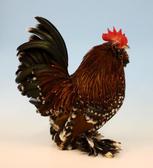
MILLEFLEUR
Male
This is very intricate and attractive colour scheme. Briefly the head is orange-red with white points. The beard is of black feathers laced with very light chamois, each feather ending with a round black spot with a white triangular tip. Neck hackle black with golden shafts, and broadly bordered with orange-red, each feather having a black end tipped with a white point. The extraordinary abundance of neck hackle makes the main colour appear wholly orange-red, the black parts being scarcely visible. Back red shading to orange towards saddle hackle. Wing bows mahogany-red, each feather tipped with white. Wing bars russet-red with lustrous green-black pea-shaped spots at the ends, finishing with silvery-white triangular tips, the whole forming regular bars across the wings. Primaries black with a thin edging of chamois on outside. The visible lower third of each secondary feather chamois, the upper two-thirds black. The remainder of wing a uniform chamois, each feather having at the end a large pea-shaped white spot on a black triangle, the tips spaced evenly to conform with the shape and outline of the wing. (Note the reversal of these pattern-markings from the normal arrangement.) Tail feathers black with a metallic green lustre, having a fine edging or lacing of dark chamois, and terminating with a white triangle. Breast, foot-feathering and the remainder of the plumage throughout of golden chamois ground colour, each feather having a light chamois shaft and finished with a black pea-shaped spot tipped with a white triangle.
Female
Ground colour uniform golden chamois, each feather terminating with a black pea-shaped spot tipped with a white triangle. Tail feathers black, finely laced with chamois and with white tips. Wing markings and other plumage as described for male, allowing for natural sexual differences.
In both sexes
The eyes are orange-red with black pupils. Beak, nails, legs and feet slate-blue.
Defects to be avoided
Ground colour too light or too washed out. White markings excessively gay or unevenly distributed.
Male
This is very intricate and attractive colour scheme. Briefly the head is orange-red with white points. The beard is of black feathers laced with very light chamois, each feather ending with a round black spot with a white triangular tip. Neck hackle black with golden shafts, and broadly bordered with orange-red, each feather having a black end tipped with a white point. The extraordinary abundance of neck hackle makes the main colour appear wholly orange-red, the black parts being scarcely visible. Back red shading to orange towards saddle hackle. Wing bows mahogany-red, each feather tipped with white. Wing bars russet-red with lustrous green-black pea-shaped spots at the ends, finishing with silvery-white triangular tips, the whole forming regular bars across the wings. Primaries black with a thin edging of chamois on outside. The visible lower third of each secondary feather chamois, the upper two-thirds black. The remainder of wing a uniform chamois, each feather having at the end a large pea-shaped white spot on a black triangle, the tips spaced evenly to conform with the shape and outline of the wing. (Note the reversal of these pattern-markings from the normal arrangement.) Tail feathers black with a metallic green lustre, having a fine edging or lacing of dark chamois, and terminating with a white triangle. Breast, foot-feathering and the remainder of the plumage throughout of golden chamois ground colour, each feather having a light chamois shaft and finished with a black pea-shaped spot tipped with a white triangle.
Female
Ground colour uniform golden chamois, each feather terminating with a black pea-shaped spot tipped with a white triangle. Tail feathers black, finely laced with chamois and with white tips. Wing markings and other plumage as described for male, allowing for natural sexual differences.
In both sexes
The eyes are orange-red with black pupils. Beak, nails, legs and feet slate-blue.
Defects to be avoided
Ground colour too light or too washed out. White markings excessively gay or unevenly distributed.
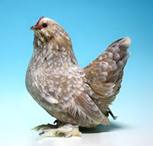
PORCELAIN
Male and Female
This is a very delicate colour pttern. Markings and patterns generally are as described for Millefleur in both sexes, with the exception that ground colour is light straw and the pea-shaped spots are pale blue, tipped with white triangles. Pale blue is substituted for the black of the Millefleur in both sexes.
The eyes are orange-red with black pupils. Beak, nails, legs and feet slate-blue.
Defects to be avoided
Ground colour too light or washed out. White markings too gay or unevenly distributed. Bareness or very poor quality feathering across the wing bows of the male.
Male and Female
This is a very delicate colour pttern. Markings and patterns generally are as described for Millefleur in both sexes, with the exception that ground colour is light straw and the pea-shaped spots are pale blue, tipped with white triangles. Pale blue is substituted for the black of the Millefleur in both sexes.
The eyes are orange-red with black pupils. Beak, nails, legs and feet slate-blue.
Defects to be avoided
Ground colour too light or washed out. White markings too gay or unevenly distributed. Bareness or very poor quality feathering across the wing bows of the male.
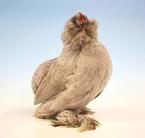
LAVENDER OR RENOLDS’ BLUE
Male and Female
This is a true breeding pale silvery blue, all the feathers being of one uniform shade.
The eyes are orange-red with black pupils. Beak, nails, legs and feet slate-blue.
Defects to be avoided
Any straw colouring in the hackles of the male.
Male and Female
This is a true breeding pale silvery blue, all the feathers being of one uniform shade.
The eyes are orange-red with black pupils. Beak, nails, legs and feet slate-blue.
Defects to be avoided
Any straw colouring in the hackles of the male.
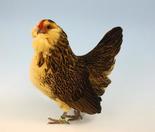
QUAIL
Male
This is a very striking colour scheme, with head feathers dark green-black, finely laced with gold. Crest of the de Watermael black ground colour, with buff lacing and buff shafts. Beard golden buff or nankin, shading darker towards the eyes, where the plumage is black, finely laced with gold. Neck hackle with brilliant black ground, sharply laced with buff, having golden lustre and yellowish-buff shafts. Back, black ground colour with gold lacing, starting in middle of the feathers and narrowing towards the tips, forming lance-like points with golden silky barbs and well-defined light ochre coloured shafts from root to point. These feathers are relatively broad under the neck, but narrower and longer nearing the saddle hackle. Colour more intense and black ground more pronounced towards the saddle hackle. Wing bows light gold, lower half of each feather black and clearly defined from the upper half, which should be nankin. Wing bars light ochre, each feather having a black triangular tip, the triangles forming two regular bars across the wing. Bottom third of secondaries chamois colour, the other two-thirds dull black. Primaries dull black, hidden when the wing is closed. Tail black with metallic green lustre, finely bordered with brown and with faintly defined light shafts. Sickles black, side-hangers black, laced with chamois, with well-defined light shafts. Breast nankin, each feather finely laced with ochre (yellowish buff), the shafts being distinct and clear. Thighs same colour as breast, abdomen and underparts greyish brown, with silky, golden barb-shaped tips.
The general effect is that in this variety all the upper parts are dark and the lower parts light, giving the appearance of the bird being covered with a dark chequered cloak. The dominating dark tint is chocolate-black, with a soft silvery lustre, known amongst artists as ‘umber’. The general light tone is nankin or yellow ochre, and well-defined light shafts are important.
Female
Head, face and neck covered with feathers which increase in size as they near the body, ground colour umber with very fine gold lacing. Crest of de Watermael umber ground colour, with gold lacing and shafts. Neck velvety, darker than the back and clearly detached from it. Shaft and lacing clearer and more golden towards the breast. Back covered with umber-coloured feathers having a silvery velvet lustre, each feather dark, finely laced with chamois and with bright nankin shafts showing in strong contrast. Wings the same colour as the back, dark umber, finely laced with chamois, feathers broader and brighter towards the lower part of the wing. Primaries are hidden when wing is closed and are dark intense umber. Tail plumage and cushion similar to back, and of same character. Breast clear, even, nankin, the shafts pale and distinct, feathers nearing the wings finely and progressively bordered with dark umber, forming a distinctive colour pattern.
In both sexes
The eyes are dark brown (nearly black) with black pupils. Legs and feet slate grey. Beak and nails horn-coloured.
Defects to be avoided
Salmon or brownish breast.
Male
This is a very striking colour scheme, with head feathers dark green-black, finely laced with gold. Crest of the de Watermael black ground colour, with buff lacing and buff shafts. Beard golden buff or nankin, shading darker towards the eyes, where the plumage is black, finely laced with gold. Neck hackle with brilliant black ground, sharply laced with buff, having golden lustre and yellowish-buff shafts. Back, black ground colour with gold lacing, starting in middle of the feathers and narrowing towards the tips, forming lance-like points with golden silky barbs and well-defined light ochre coloured shafts from root to point. These feathers are relatively broad under the neck, but narrower and longer nearing the saddle hackle. Colour more intense and black ground more pronounced towards the saddle hackle. Wing bows light gold, lower half of each feather black and clearly defined from the upper half, which should be nankin. Wing bars light ochre, each feather having a black triangular tip, the triangles forming two regular bars across the wing. Bottom third of secondaries chamois colour, the other two-thirds dull black. Primaries dull black, hidden when the wing is closed. Tail black with metallic green lustre, finely bordered with brown and with faintly defined light shafts. Sickles black, side-hangers black, laced with chamois, with well-defined light shafts. Breast nankin, each feather finely laced with ochre (yellowish buff), the shafts being distinct and clear. Thighs same colour as breast, abdomen and underparts greyish brown, with silky, golden barb-shaped tips.
The general effect is that in this variety all the upper parts are dark and the lower parts light, giving the appearance of the bird being covered with a dark chequered cloak. The dominating dark tint is chocolate-black, with a soft silvery lustre, known amongst artists as ‘umber’. The general light tone is nankin or yellow ochre, and well-defined light shafts are important.
Female
Head, face and neck covered with feathers which increase in size as they near the body, ground colour umber with very fine gold lacing. Crest of de Watermael umber ground colour, with gold lacing and shafts. Neck velvety, darker than the back and clearly detached from it. Shaft and lacing clearer and more golden towards the breast. Back covered with umber-coloured feathers having a silvery velvet lustre, each feather dark, finely laced with chamois and with bright nankin shafts showing in strong contrast. Wings the same colour as the back, dark umber, finely laced with chamois, feathers broader and brighter towards the lower part of the wing. Primaries are hidden when wing is closed and are dark intense umber. Tail plumage and cushion similar to back, and of same character. Breast clear, even, nankin, the shafts pale and distinct, feathers nearing the wings finely and progressively bordered with dark umber, forming a distinctive colour pattern.
In both sexes
The eyes are dark brown (nearly black) with black pupils. Legs and feet slate grey. Beak and nails horn-coloured.
Defects to be avoided
Salmon or brownish breast.
BLUE QUAIL
Male and Female
Similar to the Quail in all respects except that black markings are replaced by blue.
Male and Female
Similar to the Quail in all respects except that black markings are replaced by blue.
SILVER QUAIL
Male
Head covered with feathers of a dark greenish black, finely laced with white. Beard white, going darker towards the eyes, where the feathers assume a black ground colour finely laced with white. Neck hackle, silky feathers with a brilliant black ground sharply laced with white, and having light coloured shafts. Breast deep solid white with shafts being very distinct and clear. Back black to umber (chocolate/black) with a lacing of white, which starts at the middle of the feather and gets narrower towards the top, forming a lance-like point with white barbs, clearer than the lacing, ending in the upper part of the feather. The shaft well defined. Light colour divides the feather from the root to the point. These feathers are relatively broader under the neck hackle, becoming narrower and longer. Towards the saddle hackle, the colours become more intense, the black ground colour becoming more noticeable in proportion as it approaches the end of the saddle hackle feathers. Wings and bows white, the lower half of each feather black to umber and laced with white. Wing bars white, each feather having a black triangular tip, the triangles forming two regular bars across the wing. Bottom third of secondaries white, other two-thirds dull black. Primaries dull black and hidden when wing is closed. Tail black with a metallic green lustre finely bordered with dull black/umber and with finely defined light shafts. Sickles black. Thighs the same as the breast - white. Abdomen and underparts greyish white with silky white barb shaped tips.
The general effect is the same as for the normal Blue and Lavender/Dilute Quail. The upper parts are dark and the lower parts are light, giving the appearance of being covered with a dark chequered cloak. The dominant dark tint is chocolate/black with a soft silvery lustre known as ‘umber’. The light tone is white and well defined light shafts are important.
Female
Head, face and neck ground colour umber with fine white lacing. Beard as in the male. Neck velvety, darker than the back and clearly detached from it. Shaft and lacing clearer and more white towards the breast. Breast clear, even solid white. The shafts pale and distinct. Feathers nearing the wings finely and progressively bordered with dark umber, forming a distinctive pattern. Back covered with umber coloured feathers having a silvery lustre, each feather dark, finely laced with white, with bright white shafts showing in stronger contrast. Wings the same as the back, dark umber, finely laced with white feathers broader and brighter towards the lower part of the wing. Primaries are hidden when the wing is closed and are dark intense umber. Tail and cushion similar to back and of the same character.
In both sexes
The eyes dark brown (nearly black) with black pupils. Legs and feet slate grey. Beak and nails horn coloured.
Defects to be avoided
Salmon, brown or nankin on the breast.
Male
Head covered with feathers of a dark greenish black, finely laced with white. Beard white, going darker towards the eyes, where the feathers assume a black ground colour finely laced with white. Neck hackle, silky feathers with a brilliant black ground sharply laced with white, and having light coloured shafts. Breast deep solid white with shafts being very distinct and clear. Back black to umber (chocolate/black) with a lacing of white, which starts at the middle of the feather and gets narrower towards the top, forming a lance-like point with white barbs, clearer than the lacing, ending in the upper part of the feather. The shaft well defined. Light colour divides the feather from the root to the point. These feathers are relatively broader under the neck hackle, becoming narrower and longer. Towards the saddle hackle, the colours become more intense, the black ground colour becoming more noticeable in proportion as it approaches the end of the saddle hackle feathers. Wings and bows white, the lower half of each feather black to umber and laced with white. Wing bars white, each feather having a black triangular tip, the triangles forming two regular bars across the wing. Bottom third of secondaries white, other two-thirds dull black. Primaries dull black and hidden when wing is closed. Tail black with a metallic green lustre finely bordered with dull black/umber and with finely defined light shafts. Sickles black. Thighs the same as the breast - white. Abdomen and underparts greyish white with silky white barb shaped tips.
The general effect is the same as for the normal Blue and Lavender/Dilute Quail. The upper parts are dark and the lower parts are light, giving the appearance of being covered with a dark chequered cloak. The dominant dark tint is chocolate/black with a soft silvery lustre known as ‘umber’. The light tone is white and well defined light shafts are important.
Female
Head, face and neck ground colour umber with fine white lacing. Beard as in the male. Neck velvety, darker than the back and clearly detached from it. Shaft and lacing clearer and more white towards the breast. Breast clear, even solid white. The shafts pale and distinct. Feathers nearing the wings finely and progressively bordered with dark umber, forming a distinctive pattern. Back covered with umber coloured feathers having a silvery lustre, each feather dark, finely laced with white, with bright white shafts showing in stronger contrast. Wings the same as the back, dark umber, finely laced with white feathers broader and brighter towards the lower part of the wing. Primaries are hidden when the wing is closed and are dark intense umber. Tail and cushion similar to back and of the same character.
In both sexes
The eyes dark brown (nearly black) with black pupils. Legs and feet slate grey. Beak and nails horn coloured.
Defects to be avoided
Salmon, brown or nankin on the breast.
LAVENDER QUAIL
In this colour the dark upper parts of the normal Quail are replaced by pale silvery blue (uniform throughout the body) and the lower light parts are replaced by straw, varying to cream, according to the area of the body and the sex.
Male
Head feathers laced with cream. Beard cream coloured, darkening to straw towards the eyes, laced with gold. Neck Hackle sharply laced in cream with golden lustre and lightish shafts. Back cream laced with golden straw barbs and cream coloured shafts. Wing Bows light cream with the lower part of the feather clearly defined from the upper half, which should be straw coloured. Wing Bars light ochre with the bottom third of secondaries cream. Tail bordered with golden-straw. Side hangers laced with chamois. Breast cream laced with ochre, with distinct shafts. Thighs the same as the breast. Abdomen and underparts silver bluish grey with straw barb shaped tips.
Female
Head, face and neck cream laced. Beard as in the male. Breast cream, with the shafts pale and distinct. Back feathers laced with cream/straw, with light shafts. Wings the same as the back, laced with cream, going lighter towards the bottom of the wing. Tail plumage and cushion similar to back.
In both sexes
Eyes orange red with black pupils. Beak, nails, legs and feet slate blue.
Defects to be avoided
Salmon, brown, nankin or white on the breast.
In this colour the dark upper parts of the normal Quail are replaced by pale silvery blue (uniform throughout the body) and the lower light parts are replaced by straw, varying to cream, according to the area of the body and the sex.
Male
Head feathers laced with cream. Beard cream coloured, darkening to straw towards the eyes, laced with gold. Neck Hackle sharply laced in cream with golden lustre and lightish shafts. Back cream laced with golden straw barbs and cream coloured shafts. Wing Bows light cream with the lower part of the feather clearly defined from the upper half, which should be straw coloured. Wing Bars light ochre with the bottom third of secondaries cream. Tail bordered with golden-straw. Side hangers laced with chamois. Breast cream laced with ochre, with distinct shafts. Thighs the same as the breast. Abdomen and underparts silver bluish grey with straw barb shaped tips.
Female
Head, face and neck cream laced. Beard as in the male. Breast cream, with the shafts pale and distinct. Back feathers laced with cream/straw, with light shafts. Wings the same as the back, laced with cream, going lighter towards the bottom of the wing. Tail plumage and cushion similar to back.
In both sexes
Eyes orange red with black pupils. Beak, nails, legs and feet slate blue.
Defects to be avoided
Salmon, brown, nankin or white on the breast.
BLACK MOTTLED
Male and Female
All feathers black with green metallic lustre, regularly tipped with white, the tips varying in size with the feather. Excessive white markings or uneven distribution to be avoided.
In both sexes
Eyes dark red. Legs and feet slate-blue or blackish. Beak and nails dark horn.
Male and Female
All feathers black with green metallic lustre, regularly tipped with white, the tips varying in size with the feather. Excessive white markings or uneven distribution to be avoided.
In both sexes
Eyes dark red. Legs and feet slate-blue or blackish. Beak and nails dark horn.
LAVENDER MOTTLED
Male and Female
All feathers lavender, regularly tipped with white, the tips varying in size with the feather. Excessive white markings or uneven distribution to be avoided. The eyes are orange-red with black pupils. Beak, nails, legs and feet slate-blue.
Male and Female
All feathers lavender, regularly tipped with white, the tips varying in size with the feather. Excessive white markings or uneven distribution to be avoided. The eyes are orange-red with black pupils. Beak, nails, legs and feet slate-blue.
BLUE MOTTLED
Male and female
All feathers blue, regularly tipped with white, the tips varying in size with the feather. Excessive white markings or uneven distribution to be avoided. Eyes dark red. Beak, nails, legs and feet slate-blue.
Male and female
All feathers blue, regularly tipped with white, the tips varying in size with the feather. Excessive white markings or uneven distribution to be avoided. Eyes dark red. Beak, nails, legs and feet slate-blue.
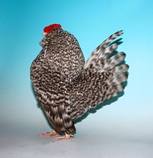
CUCKOO
Male and Female
Uniformly cuckoo coloured, with transverse bars of dark bluish grey on light grey ground. Each feather must have at least three bars.
Eyes orange-red. Legs, feet, beak and nails white, often spotted with bluish grey in young birds.
Defects to be avoided
Feathers white or spotted with white, excessive number of black feathers, red on shoulders, wings and hackle.
Male and Female
Uniformly cuckoo coloured, with transverse bars of dark bluish grey on light grey ground. Each feather must have at least three bars.
Eyes orange-red. Legs, feet, beak and nails white, often spotted with bluish grey in young birds.
Defects to be avoided
Feathers white or spotted with white, excessive number of black feathers, red on shoulders, wings and hackle.
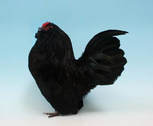
BLACK
Male and Female
Black all over, with metallic green lustre, avoiding false colouring.
Eyes black, in the de Watermael dark brown. Legs and feet blue (blackish in young birds). Beak and nails black or very dark horn.
Male and Female
Black all over, with metallic green lustre, avoiding false colouring.
Eyes black, in the de Watermael dark brown. Legs and feet blue (blackish in young birds). Beak and nails black or very dark horn.
WHITE
Male and Female
Clear white throughout, avoiding false colours and without straw tinge or yellow on the back.
Eyes orange-red. Legs, feet, beak and nails white.
Male and Female
Clear white throughout, avoiding false colours and without straw tinge or yellow on the back.
Eyes orange-red. Legs, feet, beak and nails white.
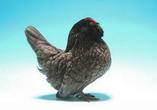
LACED BLUE
Male
Hackles, saddle, wing bows, back and tail dark slate blue, also the crest of the de Watermael. The remainder medium slate blue, each feather to show lacing of the darker shade.
Female
Medium slate blue with darker lacing all through, except head and neck which should be dark slate blue.
In both sexes
Beak dark slate or horn. Eyes dark red or red brown. Legs and feet slate. Toe nails dark slate or horn
Male
Hackles, saddle, wing bows, back and tail dark slate blue, also the crest of the de Watermael. The remainder medium slate blue, each feather to show lacing of the darker shade.
Female
Medium slate blue with darker lacing all through, except head and neck which should be dark slate blue.
In both sexes
Beak dark slate or horn. Eyes dark red or red brown. Legs and feet slate. Toe nails dark slate or horn
SPANGLED
Male
Neck hackle and saddle dark red, finely tipped with white. Breast and thighs black finely and evenly tipped with white. Beard black tipped with white. Wings, wing bow dark red, finely tipped with white: secondaries deep bay intermixed with white. Tail ,sickles and side hangers tipped with white. Straight feathers black intermixed with white.
Female
Neck, hackle golden-red streaked with black, finely tipped with white. Breast and thighs dark salmon, finely tipped with white, beard as breast. Back and shoulders partridge coloured feathers, finely and evenly tipped with white. Wings, secondaries, partridge intermixed with white, partridge predominating; primaries, dark intermixed with white. All other feathers partridge colour finely and evenly tipped with white.
In both sexes
Legs white.
Male
Neck hackle and saddle dark red, finely tipped with white. Breast and thighs black finely and evenly tipped with white. Beard black tipped with white. Wings, wing bow dark red, finely tipped with white: secondaries deep bay intermixed with white. Tail ,sickles and side hangers tipped with white. Straight feathers black intermixed with white.
Female
Neck, hackle golden-red streaked with black, finely tipped with white. Breast and thighs dark salmon, finely tipped with white, beard as breast. Back and shoulders partridge coloured feathers, finely and evenly tipped with white. Wings, secondaries, partridge intermixed with white, partridge predominating; primaries, dark intermixed with white. All other feathers partridge colour finely and evenly tipped with white.
In both sexes
Legs white.
OCHRE WHITE MILLEFLEUR
Male
The head is buff with white points,. The beard is of white feathers laced with light buff each feather ending with a white spot. Neck hackle white with buff shafts and broadly bordered with buff each feather having a white spot at end. The extraordinary abundance of neck hackle makes the main colour appear wholly buff, the white parts being scarcely visible. Back dark buff shading lighter towards saddle hackle. Wing bows deep buff, each feather tipped with white; rich buff with white pea shaped spots at ends, the whole forming regular bars across the wings. Primaries, white with a thin edging of light buff on outside; the visible lower third of each end a large pea shaped white spot, the tips spaced evenly to conform with shape and outline of wing. Tail feathers white, having a fine edging or lacing of buff, and terminating with a white tip. Breast, foot feathering and remainder of plumage throughout an even buff ground colour each feather having a light buff shaft and finished with a white pea shaped spot.
Female
Ground colour uniform buff, each feather terminating with a white pea shaped spot. Tail feathers white finely laced with buff and with white tips, wing markings and other plumage as described for male, allowing for natural sexual differences.
In both sexes
Eyes orange red with black pupils. Beak and nails slate-blue. Legs and feet slate-blue.
Defects to be avoided
Ground colour too light or washed out, white markings excessively gay or unevenly distributed and any black or blue feathers or spots in feathers.
Male
The head is buff with white points,. The beard is of white feathers laced with light buff each feather ending with a white spot. Neck hackle white with buff shafts and broadly bordered with buff each feather having a white spot at end. The extraordinary abundance of neck hackle makes the main colour appear wholly buff, the white parts being scarcely visible. Back dark buff shading lighter towards saddle hackle. Wing bows deep buff, each feather tipped with white; rich buff with white pea shaped spots at ends, the whole forming regular bars across the wings. Primaries, white with a thin edging of light buff on outside; the visible lower third of each end a large pea shaped white spot, the tips spaced evenly to conform with shape and outline of wing. Tail feathers white, having a fine edging or lacing of buff, and terminating with a white tip. Breast, foot feathering and remainder of plumage throughout an even buff ground colour each feather having a light buff shaft and finished with a white pea shaped spot.
Female
Ground colour uniform buff, each feather terminating with a white pea shaped spot. Tail feathers white finely laced with buff and with white tips, wing markings and other plumage as described for male, allowing for natural sexual differences.
In both sexes
Eyes orange red with black pupils. Beak and nails slate-blue. Legs and feet slate-blue.
Defects to be avoided
Ground colour too light or washed out, white markings excessively gay or unevenly distributed and any black or blue feathers or spots in feathers.
ERMINE (COLUMBIAN)
Male and female
Head pure white. Beard White, Neck hackle white with distinct broad black stripe down the centre of each feather, free from white shaft, such stripe to be entirely surrounded by a clearly defined white margin, finishing with a decided white tip, free from black outer edging, black tips and excess of greyness at the throat. Saddle hackle pure white. Tail, main feathers black with beetle green sheen; coverts black with beetle green sheen either laced or not with white. Wings, primaries black or black edged with white; secondary, black on the inner edge and white on the outer edge; remainder pure white, entirely free from ticking. Under colour; white, bluish-white or light slate, not to be visible when feathers are undisturbed. The Female hackle bright intense black each feather entirely surrounded by a well defined white margin. Tail feathers black, except the top pair which may or may not be laced with white. Legs & Feet slate grey, Beak and nails horn
Male and female
Head pure white. Beard White, Neck hackle white with distinct broad black stripe down the centre of each feather, free from white shaft, such stripe to be entirely surrounded by a clearly defined white margin, finishing with a decided white tip, free from black outer edging, black tips and excess of greyness at the throat. Saddle hackle pure white. Tail, main feathers black with beetle green sheen; coverts black with beetle green sheen either laced or not with white. Wings, primaries black or black edged with white; secondary, black on the inner edge and white on the outer edge; remainder pure white, entirely free from ticking. Under colour; white, bluish-white or light slate, not to be visible when feathers are undisturbed. The Female hackle bright intense black each feather entirely surrounded by a well defined white margin. Tail feathers black, except the top pair which may or may not be laced with white. Legs & Feet slate grey, Beak and nails horn
FAWN ERMINE (BUFF COLUMBIAN)
Male and Female
Coloured As Columbian but the white parts are replaced by Buff.
Male and Female
Coloured As Columbian but the white parts are replaced by Buff.
GOLD PARTRIDGE
Male
Head orange reddish brown. Beard Black. Neck hackle a gradual transition from orange to light orange yellow, each feather having a greenish-black middle stripe. Back deep reddish- brown. Side hackle corresponding with neck hackle, a little darker permitted. Breast black with green sheen, free from markings or spots. Wing bow black, shoulders deep reddish-brown, wing bar iridescent greenish-black: primaries inner web and tip black, outer web chestnut-brown; secondaries inner web black, outer web chestnut-brown; wing bay chestnut-brown when wing is closed. Thighs deep black with green sheen, free from markings or spots. Abdomen black. Tail main feathers, sickles and tail coverts green iridescent black, the tail coverts nearest the side hangers with a brownish edge underneath at the tip. Undercolour greyish.
Female
Head gold-brown. Beard light salmon brown, Throat greyish white. Neck hackle goldish-yellow with a black middle stripe. Wing, back, saddle and tail coverts greyish-brown with fine black peppering, as even as possible, free of rust or red. Tail feathers blackish, the top feather on each side with brown peppering, breast light salmon-brown, shading to brownish grey near the thighs. Thighs and down ash grey.
In both sexes
Eyes orange-red Legs and feet slate-blue. Beak and nails dark horn
Male
Head orange reddish brown. Beard Black. Neck hackle a gradual transition from orange to light orange yellow, each feather having a greenish-black middle stripe. Back deep reddish- brown. Side hackle corresponding with neck hackle, a little darker permitted. Breast black with green sheen, free from markings or spots. Wing bow black, shoulders deep reddish-brown, wing bar iridescent greenish-black: primaries inner web and tip black, outer web chestnut-brown; secondaries inner web black, outer web chestnut-brown; wing bay chestnut-brown when wing is closed. Thighs deep black with green sheen, free from markings or spots. Abdomen black. Tail main feathers, sickles and tail coverts green iridescent black, the tail coverts nearest the side hangers with a brownish edge underneath at the tip. Undercolour greyish.
Female
Head gold-brown. Beard light salmon brown, Throat greyish white. Neck hackle goldish-yellow with a black middle stripe. Wing, back, saddle and tail coverts greyish-brown with fine black peppering, as even as possible, free of rust or red. Tail feathers blackish, the top feather on each side with brown peppering, breast light salmon-brown, shading to brownish grey near the thighs. Thighs and down ash grey.
In both sexes
Eyes orange-red Legs and feet slate-blue. Beak and nails dark horn
SILVER PARTRIDGE
Male
As the gold partridge male in the black feathered parts and in the markings on the neck and saddle hackles The orange and light orange yellow and the brown replaced by silvery white
Female
Head silver-white Hackle silver-white, each feather having a black middle stripe. Wing coverts, back, saddle and tail coverts muted silver or slate grey with fine black peppering as even as possible, free from flecks, rust brown or yellow. Tail feathers blackish, the top feather on each side with silver peppering. Breast light salmon-brown, fading to ash-grey underneath. Beard the colour of breast. Rump and rear parts ash-grey. Thighs ash-grey with some peppering.
In both sexes
Beak dark horn, legs slate-blue. Faults any mismarked feathers. Any splashing or coloured feathers in black parts of male. Red in plumage of male. Rusty colour in wings of female.
Male
As the gold partridge male in the black feathered parts and in the markings on the neck and saddle hackles The orange and light orange yellow and the brown replaced by silvery white
Female
Head silver-white Hackle silver-white, each feather having a black middle stripe. Wing coverts, back, saddle and tail coverts muted silver or slate grey with fine black peppering as even as possible, free from flecks, rust brown or yellow. Tail feathers blackish, the top feather on each side with silver peppering. Breast light salmon-brown, fading to ash-grey underneath. Beard the colour of breast. Rump and rear parts ash-grey. Thighs ash-grey with some peppering.
In both sexes
Beak dark horn, legs slate-blue. Faults any mismarked feathers. Any splashing or coloured feathers in black parts of male. Red in plumage of male. Rusty colour in wings of female.
